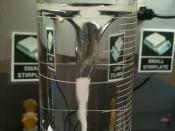Biology Practical Assessment Task:Water conservation in plantsTopic: 1 ÃÂ Maintaining a BalanceIntroduction: Many plants in Australia live in areas that experience very little rain and very high temperatures. Water loss occurs through the stomates in the leaves, but carbon dioxide uptake also occurs through these structures. These plants cannot simply close the stomates because the chlorophyll-containing (mesophyll) cells of the leaf need carbon dioxide for photosynthesis. Some plants have developed a variety of adaptations that allow them to reduce transpiration from their leaves without having to close their stomates.
What are the Other members of group: A. Amelia Spoulos, Nivesh Ravindran, Esther Polur, Ruby Vegesana and Caitlin Wood.
B. Amelia Spoulos and Nivesh RavindranWhat I am going to investigate: A. I am going to investigate stomate distribution in terrestrial plants. From gathering this information, I will then be able to make inferences about the stomate distribution in terrestrial plants.
B. I am also going to investigate the structural features of leaves of various plants that assist in the conservation of water.
What I think will happen: A. I think that when I investigate the stomate distribution in terrestrial plants, I will find that terrestrial plants have their stomates on the underside of their leaves. From this, I can predict a couple of things that will happen in my experiment. Firstly, the plant which does not have its stomates blocked will excrete the most water because the water is able to escape into the environment. I also can predict that when using terrestrial plants, the plant with the lower epidermis covered will expel less or even no water, compared to the plants with only the upper epidermis covered. This is because we would expect the stomates on terrestrial plants to be located on the lower epidermis as this is an adaptation...


